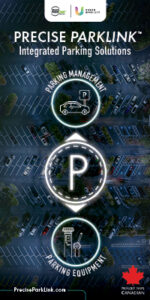What Parking Owners Need to Know Before Creating an EV Plan
By Bob Andrews
The electric vehicle age is coming, and it will have a significant impact on parking owners across Canada. Both the national government and the automakers themselves have set aggressive EV goals. The Canadian government has mandated that all new light-duty vehicle sales must be zero-emission by 2035, with interim targets set at 20% by 2026 and 60% by 2030. Furthermore, at least 35% of new medium- and heavy-duty vehicle sales must by ZEVs by 2030, with full adoption by 2040 “where feasible.”
Automakers’ targets are just as aggressive. General Motors plans to produce only EVs by 2035 and Volvo plans to be fully electric by 2030. As a result of these impending changes, parking owners must now figure out how to add EV charging to their parking assets, how much to add, and most importantly, which technology to implement. Most charging will occur in parking facilities, particularly those that provide long-term parking, so the transition to electric vehicles will have a particularly pronounced impact on parking owners and institutions with parking assets.
At least for now, adding EV chargers is primarily a matter of being able to offer an attractive user amenity. But there are financial reasons to be focused on EV charging too. Parking is already an important source of income for many properties and institutions, and monetizing EV charging will just make parking more valuable. However, owners will only realize the full potential value of their EV infrastructure if they plan carefully and make the right choices when selecting their EV technology.
Choosing the Right EV Hardware and Software
With the rapid rate of EV adoption that we’re experiencing now, it may be tempting to find a quick solution or the cheapest option for efficiency’s sake—to “get it and forget it or just to tick a box.” The problem with this approach is that it can tie your hands in the future as you continue to add EV technology to your facilities and the technology evolves. If you do this, you may find your avenues limited. Because you chose the quickest or cheapest option, you may not be able to access new technologies as they are introduced, that can improve the charging experience for your parkers.
For instance, if you make a hasty choice you may end up with a closed system with chargers that can only be operated with software provided by the hardware provider. Why is this a problem? With a closed system, your EV chargers can only do what that provider equips its tools to do. If your customers need additional capabilities, you are out of luck. And if they lag other EV brands in developing new offerings down the road, you may be stuck with inadequate equipment and its capabilities (or lack of capabilities). Or you can replace it at great expense. Also, if your equipment has issues, you may be limited to the closed system’s service and repair network, which can lead to lengthy delays and long equipment downtimes. Also, repairs could be very expensive because you are stuck relying solely on their providers.
Therefore, with a closed system, you are held hostage in several ways. You’re limited by their hardware development. So, if they don’t add features in future that other EV providers do offer, you will be stuck with equipment or software that won’t meet your needs. Unless you change systems, which would be costly. Or you may have to run two or more systems. Also, you become a “captured customer,” with limited or no negotiating leverage when purchasing new equipment. So, you are hostage to their pricing model as well.
Also, many parking owners serve different use cases with different patron bases. For instance, commercial properties have a multitude of different types of tenants, each of which may have different charging needs. Airports, on the other hand, may need to provide for hourly parkers, permit parkers, long-term parkers, and airport vehicles. Then there are universities, which may need to provide charging to students, staff, and faculty, and which may want to have different rates and rules for each. Or maybe your parkades and lots offer different pricing models with hourly parkers paying one rate for charging and VIP or loyalty parkers paying a discounted rate. Not all major EV software providers can manage such a variety of uses.
If your software can’t cater to different use cases and patron bases, you won’t be able to serve your charging patrons adequately. This can put you at a significant competitive disadvantage when trying to attract charging customers—particularly if you are competing with other parking owners for parking business, and those facilities offer more EV options. And if you are locked into a closed system, you can’t just switch to new operation software; you need to either live with your equipment’s shortcomings or rip your chargers out and replace them.
If you hope to monetize your EV charging equipment, a closed system presents additional disadvantages. First and foremost, you’ll need to share a substantial portion of your revenues with your EV provider. Doesn’t it make more sense to install equipment that will allow you to keep the revenues you are generating from EV charging?
Sometimes these providers even insist that users join their network to charge with their equipment. That’s great for EV hardware providers because they have a captured customer base; but it’s not necessarily good for drivers who want to charge their vehicles in your parking facility. Requiring them to join another provider’s network isn’t exactly the definition of good customer service. In addition to aggravating your customers, this approach dilutes your brand. You want the equipment that you are paying to install, and which is serving your patrons, to carry your branding, not some third party. And you want to have the flexibility to manage your equipment the way you want to, not the way some technology provider dictates.
Urgency Vs. Opportunity
It’s understandable that parking owners and institutions and other organizations with parking assets may feel a sense of urgency when it comes to choosing and installing EV charging equipment. But do your homework because not all charging equipment, and not all charging software standards are created equal. Identify your short and long-term goals for your plan and find the hardware and software that will provide the reliability and flexibility you and your patrons need, and which can grow and adapt as your needs grow and adapt. If you do, you’ll have an EV charging solution that will meet your needs for years to come.
About the author:
Bob Andrews is Founder of Zevtron, an EV Charger Solutions company serving the United States and Canada. He can be reached at bandrews@zevtron.com.






